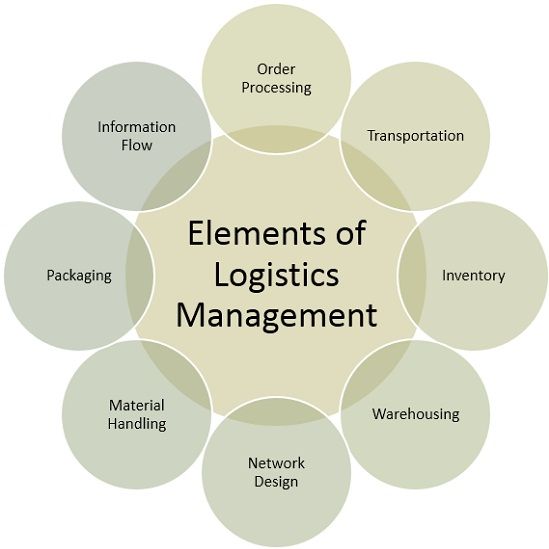Definition: Logistics management refers to the comprehensive planning, organization and controlling of physical flow, storage and movement of materials, equipment, supplies, finished goods and related information from the point of origin to the point of consumption, to satisfy the customer’s needs, at a profit. The movement of goods implies the forward and reverse flow of goods or materials.
It is a segment of supply chain management, as it occurs at various stages of the supply chain.
Elements of Logistics Management
There are eight important elements or say components of logistics management which are discussed below:
Order processing
Order processing plays an important role in logistics management. It covers order preparation, order entry, order filling, order status reporting, a quality checklist of the product, delivery schedule and location of delivery.
Factors to be considered:
- Cost of order processing
- Capability of the company in producing the product
- List of specifications
Transportation
Transportation refers to the spatial connection for the physical movement of goods in supply chain. It is the operational part of logistics which tends to geographically move and place the inventory. The three important factors which gauge the transportation performance are – cost, speed and consistency.
It includes mode and transport service selection, speed of transportation, ambience requirement for material, cost of transportation, vehicle scheduling, carrier routing, equipment selection, claims processing, etc
Factors to be considered:
- Exigency of the product
- Transportation cost
Inventory
In logistics management, the management and control of inventory is very important with respect to what and how much of a stock to hold and where the stock is located. It controls the movement of goods going into and out of the warehouse.
It ensures that the inventory levels are to be maintained so as to meet the customers demand in time along with keeping the carrying cost low.
Factors to be considered:
- Inventory control at the initial stage
- Lead time
- Cost of raw material
Warehousing
A warehouse is a place where a company stores the raw materials, semi-finished products and finished produces. Its functions include stockpiling, stock mixing, transloading and contingency protection.
It considers the location of the warehouse, inventory level at the warehouse, storage requirement of the product, the shelf life of the product.
Factors to be considered
- Availability of space
- Strategic location
- Packing and repacking facilities
- Material handling system
Network design
The supply chain is a manifold network of facilities and organization with varied objectives, as it consists of suppliers, warehouses, distribution centres and retail outlets. It specifies the route through which the goods will move from their source/origin points to the demand points to align the supply and demand.
It has five aspects, i.e. strategic, tactical, operational, spatial and temporal.
Factors to be considered
- Effective route for transportation
- Inbound logistics
- Outbound logistics
Materials Handling
Material Handling covers all the activities concerned with the movement of raw material, work in progress and finished goods, within the factory or warehouse.
It includes decisions such as facility configuration, material handling system selection, stock locator and arrangement, space layout, dock design, equipment replacement, material default location, handling requirements (fragile or inflammable) and order picking operations.
Factors to be considered:
- Material breakage
- Pilferage
- Cost of handling
- Number of handlings.
Packaging
The packaging is meant to protect and hold the product while it is transported and stored, as well as to communicate the message to the customers. Multiple levels of packaging may increase the cost to the manufacturer but inadequate packaging will damage, which will lead to customer dissatisfaction.
In general, three levels of packaging is preferred – primary packaging, secondary packaging and final packaging.
Factors to be considered:
- Protection
- Holding requirements
- Display of the message
- Cost of packaging
- Reverse logistics for packaging
- Recycling of the material used for packaging
Information flow
Otherwise called as information processing. It is something that links all the aspects of the logistics system in a single thread. There is a continuous flow of information throughout the logistics process.
With the help of latest technology and software packages, it is easier to get real-time updates and tracking of the order location. This data can be used by the parties to track packages and manage demand.
Factors to be considered:
- Software package
- Effective tracking system
- GPS system
Conclusion
Logistics Management aims to provide the right quantity of goods to the right location in the right time. It finds out the potential distributors and suppliers and ascertaining how effective or convenient are they, to select the best ones.

Leave a Reply